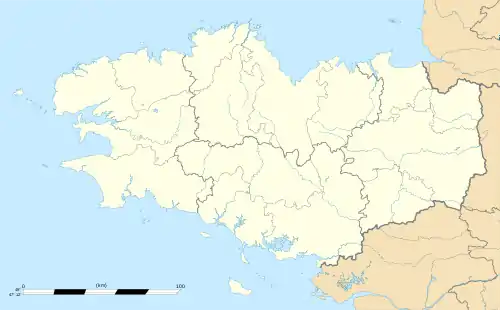Concarneau
Concarneau (Breton: Konk-Kerne, meaning Bay of Cornouaille) is a commune in the Finistère department of Brittany in north-western France.[2] Concarneau is bordered to the west by the Baie de La Forêt.
Concarneau
Konk-Kerne | |
|---|---|
 Concarneau's harbour and centre | |
.svg.png.webp) Coat of arms | |
Location of Concarneau 
| |
 Concarneau  Concarneau | |
| Coordinates: 47°52′34″N 3°55′04″W | |
| Country | France |
| Region | Brittany |
| Department | Finistère |
| Arrondissement | Quimper |
| Canton | Concarneau |
| Government | |
| • Mayor (2014–2020) | André Fidelin |
| Area 1 | 41.08 km2 (15.86 sq mi) |
| Population (2017-01-01)[1] | 19,050 |
| • Density | 460/km2 (1,200/sq mi) |
| Time zone | UTC+01:00 (CET) |
| • Summer (DST) | UTC+02:00 (CEST) |
| INSEE/Postal code | 29039 /29900 |
| Elevation | 0–36 m (0–118 ft) |
| 1 French Land Register data, which excludes lakes, ponds, glaciers > 1 km2 (0.386 sq mi or 247 acres) and river estuaries. | |
The town has two distinct areas: the modern town on the mainland and the medieval Ville Close, a walled town on a long island in the centre of the harbour. Historically, the old town was a centre of shipbuilding. The Ville Close is now devoted to tourism with many restaurants and shops aimed at tourists. However restraint has been shown in resisting the worst excesses of souvenir shops. Also in the Ville Close is the fishing museum. The Ville Close is connected to the town by a bridge and at the other end a ferry to the village of Lanriec on the other side of the harbour.
Events
In August the town holds the annual Fête des Filets Bleus (Festival of the blue nets). The festival, named after the traditional blue nets of Concarneau's fishing fleet, is a celebration of Breton and pan-Celtic culture. Such festivals can occur throughout Brittany but the Filets Bleus is one of the oldest and largest, attracting in excess of a thousand participants in traditional dress with many times that number of observers. In 2005, the 100th festival was celebrated.
Literature
Concarneau was the setting for Belgian mystery writer Georges Simenon's 1931 novel Le Chien jaune (The Yellow Dog), featuring his celebrated sleuth Maigret.
Economy
Fishing, particularly for tuna, has long been the primary economic activity in Concarneau. The Les Mouettes d'Arvor is one of the last traditional canning factories in Concarneau. Concarneau is one of the biggest fishing ports in France. Since the 1980s, other industries have arisen, such as boat construction and summer tourism.
The Ville Close separates the working port from the yacht basin.

Population
Inhabitants of Concarneau are called in French Concarnois.
| Year | Pop. | ±% |
|---|---|---|
| 1793 | 3,908 | — |
| 1800 | 3,692 | −5.5% |
| 1806 | 3,818 | +3.4% |
| 1821 | 3,484 | −8.7% |
| 1831 | 4,031 | +15.7% |
| 1836 | 4,137 | +2.6% |
| 1841 | 4,396 | +6.3% |
| 1851 | 4,944 | +12.5% |
| 1856 | 5,021 | +1.6% |
| 1861 | 5,575 | +11.0% |
| 1866 | 6,633 | +19.0% |
| 1872 | 7,884 | +18.9% |
| 1876 | 8,508 | +7.9% |
| 1881 | 9,516 | +11.8% |
| 1886 | 9,659 | +1.5% |
| 1891 | 11,754 | +21.7% |
| 1896 | 12,875 | +9.5% |
| 1901 | 14,757 | +14.6% |
| 1906 | 15,869 | +7.5% |
| 1911 | 14,784 | −6.8% |
| 1921 | 12,943 | −12.5% |
| 1926 | 12,722 | −1.7% |
| 1931 | 12,559 | −1.3% |
| 1936 | 12,704 | +1.2% |
| 1946 | 13,369 | +5.2% |
| 1954 | 13,420 | +0.4% |
| 1962 | 15,907 | +18.5% |
| 1968 | 17,801 | +11.9% |
| 1975 | 18,759 | +5.4% |
| 1982 | 17,984 | −4.1% |
| 1990 | 18,630 | +3.6% |
| 1999 | 19,453 | +4.4% |
| 2008 | 20,096 | +3.3% |
Breton language
In 2008, 2.16% of primary-school children attended bilingual schools, where Breton language is taught alongside French.[3]
Sport
The football club US Concarneau is based in the town.
Personalities
- Michel Desjoyeaux, navigator
- Samantha (Sam) Davies, sailor
- Guy Cotten, founder of a clothes factory
- Stéphane Guivarc'h, French footballer, won the FIFA World Cup 1998 with the French national side
- Théophile Deyrolle and Alfred Guillou, founders of the Concarneau Art Colony.
- Valérie Hermann President of Ralph Lauren
International relations
Twinned towns:
Gallery
.jpg.webp) The medieval Ville Close
The medieval Ville Close The medieval Ville Close
The medieval Ville Close The commercial harbour
The commercial harbour The yachting harbour
The yachting harbour At dusk
At dusk The port
The port The yachting harbor
The yachting harbor.jpg.webp) Château de Kériolet
Château de Kériolet Les Sables Blancs
Les Sables Blancs The Ville Close
The Ville Close Duquesne
Duquesne Concarneau's location in Finistère
Concarneau's location in Finistère
See also
References
- "Populations légales 2017". INSEE. Retrieved 6 January 2020.
- Chisholm, Hugh, ed. (1911). . Encyclopædia Britannica. 6 (11th ed.). Cambridge University Press. p. 823.
- (in French) Ofis ar Brezhoneg: Enseignement bilingue
External links
| Wikimedia Commons has media related to Concarneau. |
- Official website (in French)
- Base Mérimée: Search for heritage in the commune, Ministère français de la Culture. (in French)